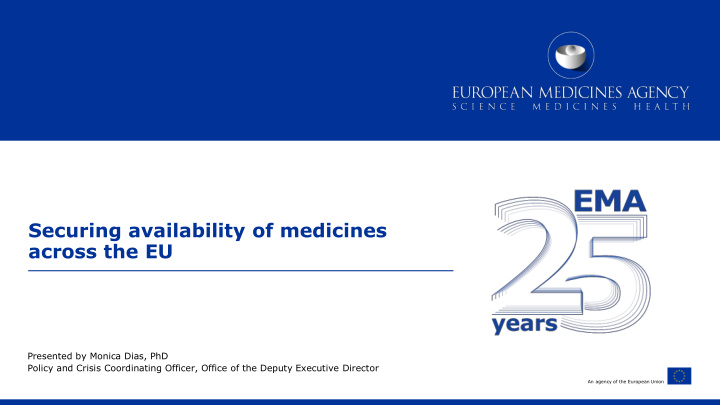



Securing availability of medicines across the EU Presented by Monica Dias, PhD Policy and Crisis Coordinating Officer, Office of the Deputy Executive Director An agency of the European Union
Background: How does the EU manage shortages? • Improving the availability of medicines authorised in the EU is a key priority for the European medicines regulatory network. In the EU, most medicine shortages are dealt with at national level by national competent authorities. • In December 2016, a joint HMA/EMA Task Force on the Availability of Authorised Medicines for Human and Veterinary Use was established in order to provide strategic support and advice to tackle disruptions in supply of human and veterinary medicines and ensure their continued availability. • In April 2019, the task force established a single point of contact (SPOC) network to improve information sharing between MS, EMA and the European Commission on shortages of critical human and veterinary medicines. This includes information sharing on alternative medicines available in other Member States. 1 Classified as public by the European Medicines Agency
Main root causes of shortages in the context of the pandemic Temporary lockdowns of manufacturing sites; • Travel restrictions impacting exports; • Export bans; • Increased demand for medicines used to treat COVID-19 patients; • Stockpiling by hospitals, by individual citizens or at Member State level. • 2 Classified as public by the European Medicines Agency
Products currently in shortage or at risk of shortage Medicines used off label for the treatment of COVID-19 (e.g. chloroquine, • hydroxychloroquine, monoclonal antibodies) Medicines used in intensive care units: • Anaesthetics • Antibiotics • Analgesics • Sedatives • 3 Classified as public by the European Medicines Agency
Responding to the COVID-19 pandemic In the context of the COVID-19 pandemic, EMA is going beyond its legal remit and has initiated a number of activities, as follows: EMA set up the EU Exe Steering Group on shortages of medicines caused by major events • which meets every week, also with industry associations; EMA launched a survey to all MAHs in March 2020 on the impact of the COVID-19 • pandemic on the availability of CAPs; EMA launched the i-SPOC system in April 2020, a fast-track monitoring system, to help • prevent and mitigate supply issues. 4 Classified as public by the European Medicines Agency
EU Executive Steering Group on shortages caused by major events (EC, EMA, HoAs) Provides strategic leadership for urgent and coordinated action to prevent and mitigate • supply disruptions within the EU during the pandemic. Composed of representatives from EMA, European Commission, HMA, Coordination groups • for Mutual-recognition and Decentralised Procedures for human and veterinary medicines (CMDh and CMDv) and risk communication specialists. Chaired by the European Commission. • Meets with industry associations on a weekly basis. • 5 Classified as public by the European Medicines Agency
EU Single point of contact (SPOC) network In the context of COVID-19, the EU SPOC Network: Continues sharing information between Member States, EMA and the European • Commission on critical medicine shortages in the context of COVID-19 Gathered information on medicines used for COVID-19 patients (ICU setting) • currently on shortages or at risk of shortage . This info has been used by the Health Commissioner to make a plea for industry to increase production of these medicines. In addition, due to export restrictions imposed by the Indian Government, EMA collected • demand data from MSs (through the NCA SPOCs) for 14 APIs under export restrictions . This data was used by the Health Commissioner in direct negotiations with the Indian Government. 6 Classified as public by the European Medicines Agency
i-SPOC reporting system between industry and EU regulatory authorities • Requested by pharmaceutical industry for reporting shortages of COVID-19 medicines only, and agreed by the EU Exe SG and launched in April 2020 • Scope is to allow direct reporting to EMA by MAHs of supply shortages for crucial CAPs and NAPs used in the context of COVID-19, in parallel to reporting to the NCAs concerned • Designed to collect information on current or anticipated supply disruptions and their causes in relation to COVID-19 medicines (primarily used in ICU setting). • Aims at preventing shortages from occurring, by initiating action through the EU Exe SG to address root causes or enable mitigating actions (e.g. regulatory flexibility or actions at EC/MS level on matters affecting supply of medicines or related materials, on logistics, export restrictions). 7 Classified as public by the European Medicines Agency
Industry-SPOC network EU SPOC network NCA Notification of i-SPOCs Notification of SPOCs critical shortages for shortages ICU medicines NCA EMA EC EMA SPOCs 8 Classified as public by the European Medicines Agency
Regulatory flexibility to prevent/mitigate shortages Guidance is available for companies on adaptations to the regulatory framework to address challenges arising from the COVID-19 pandemic First version was published 10 April 2020 • To be considered when deciding on mitigation • measures for shortages It is regularly updated to address new questions • Guidance for medicine developers and companies for COVID-19: Guidance on regulatory expectations and flexibility (human medicines) Guidance for medicine developers and companies for COVID-19: Guidance on regulatory expectations and flexibility (veterinary medicines) 9 Classified as public by the European Medicines Agency
Any questions? Further information Monica.Dias@ema.Europa.eu Official address Domenico Scarlattilaan 6 ● 1083 HS Amsterdam ● The Netherlands Send us a question Go to www.ema.europa.eu/contact Telephone +31 (0)88 781 6000 Follow us on @EMA_News
Recommend
More recommend